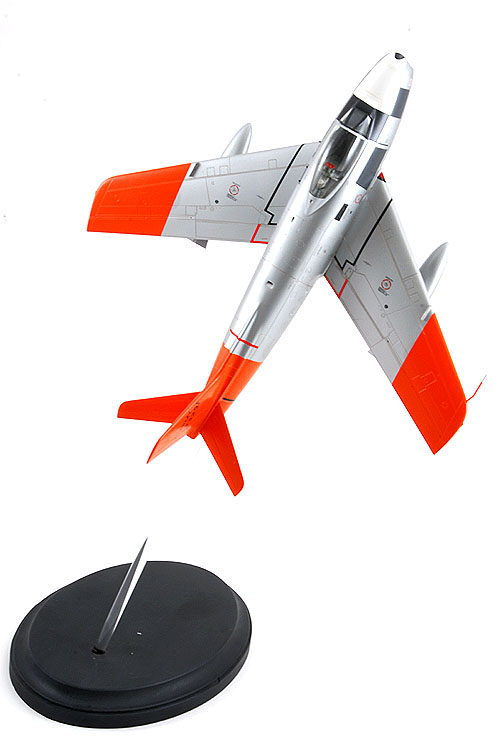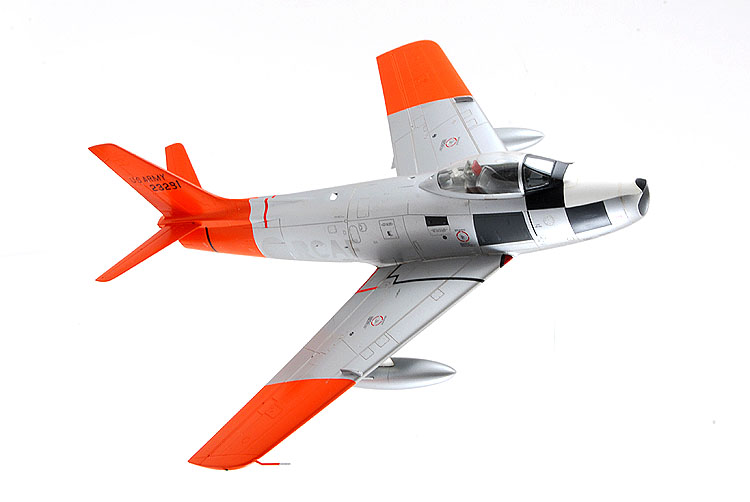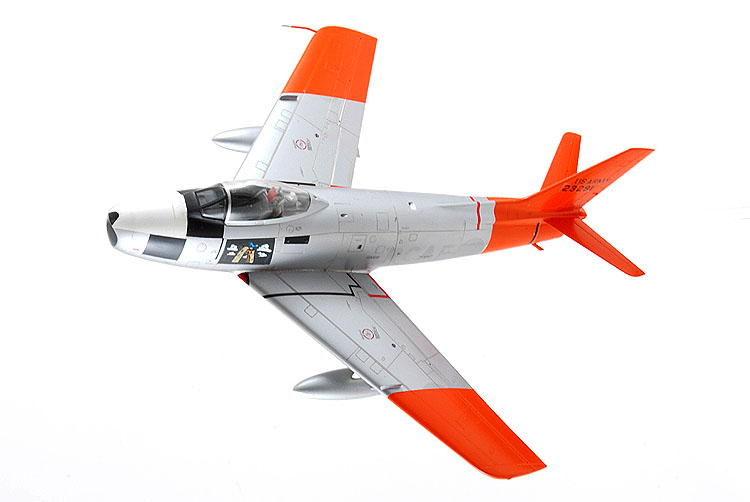

Before you go any further - yes, I know there is no pilot in the cockpit. The QF-86 was a pilotless drone.
Kit:
Aftermarket:
Date:
Academy (2162)
None
2010
All airplanes must eventually stop flying. Some die in combat, others succumb to the chop saw and smelter of the scrap man. A lucky few retire to be placed on display in museums,
but thereís an even smaller number that end their service, quite literally, in a blaze of glory.
In case you havenít noticed by now, I like brightly coloured airplanes, mostly civilian ones. But occasionally thereís a subject that crosses over these boundaries.
In the 1970s the United States military was perfecting various missile systems and needed some full-size aircraft to serve as sacrificial drones. Luckily for them, the Canadian
Air Force had all sorts of retired Sabres. I liked the appearance of the ghost RCAF markings, contrasting against splashes of bright colours. I also liked the idea of building a
pilotless drone and showing it flying without a pilot.
Many years ago, Iíd purchased an Academy F-86 for a project I later lost interest in building and my kit quietly ended up in the Kitstash, migrating further and further from the
"active" pile with each passing month. Then a few years ago a member in the local modelling club came to the rescue by challenging members to all build the same subject so we
could see what variations we could get. In one quick swoop, my came down and landed squarely on my modelling bench.
Academy released their nice, modern quality Sabre somewhere back around 2000 and along with easy to work with light grey styrene, the kit included recessed panel lines, detailed gun
bays, two pilot figures and a separate engine and display stand. Although I wasnít going to use any of these options, they were nice additions to a kit thatís roughly half the price
of its competition.
There are noticeable sink marks on the ammunition/gun bay panels, landing gear doors and speed brakes.
This is my third Academy Sabre, so construction was straight forward. I knew Iíd need a touch of liquid putty on the drop tanks, and for blending the lower fuselage to the lower
wing centre section.
In my thinking, leaving a pilotless drone on its landing gear does nothing to indicate that my subject is pilotless. To convey that message, Iíd need to show my model in
an in-flight display. Closing the multi-piece landing gear doors was a challenge because the parts are way too small. Careful gluing and then some work with super glue and putty
took care of everything.
Super glue and putty also filled in the machine gun ports.
Information on QF-86 systems was non-existent when I built my model, and usually finishing such a project opens a floodgate of new information. That hasnít happened, even years
after I finished my model. What I did add was a pair of panels below and behind the canopy. It appears these were control panels with lights that would indicate if the drone
system was working.
I started painting my QF-86 with white paint. This was necessary for the nose, but also as an undercoat for the International Orange. I experimented with Games Workshopí White
Metal for the aluminum. For an acrylic, it seemed to work alright.
To replicate the ghost images of the RCAF markings, I cut masks from printer paper and then airbrushed a slightly darker shade of silver. Depending on which direction the light
hits the model, theyíre either as plain as day, or completely invisible.
The final step was to hand paint the nose art that adorns both ammunition/gun bay panels. Itís hard to believe but there are seven or eight colours in an area the size of my
fingernail.
From the start, I knew this model wasnít intended to be a contest winner, but Iím still pleased with how well it turned out. More importantly, I was able to snatch a kit out of
storage and get it built.
What really surprised me was the reaction my model received at its first public appearance. Even though I noted on my contest entry form that it was a pilotless drone, people
still told me Iíd screwed up and forgotten a pilot.

One challenge I faced with this colour scheme was the 'ghost' RCAF markings. If you look closely at the mid-fuselage you can spot the letters R-C-A-F. I did this by adding just a touch of a darker silver to my Games Workshop White Metal paint.

On the left-hand side ammunition compartment door there was some nose art. After studying the picture really closely I determined it was the Looney Tunes Coyote chasing the Roadrunner. Custom colours were mixed and the nose art was painted by hand using very fine paint brushes.